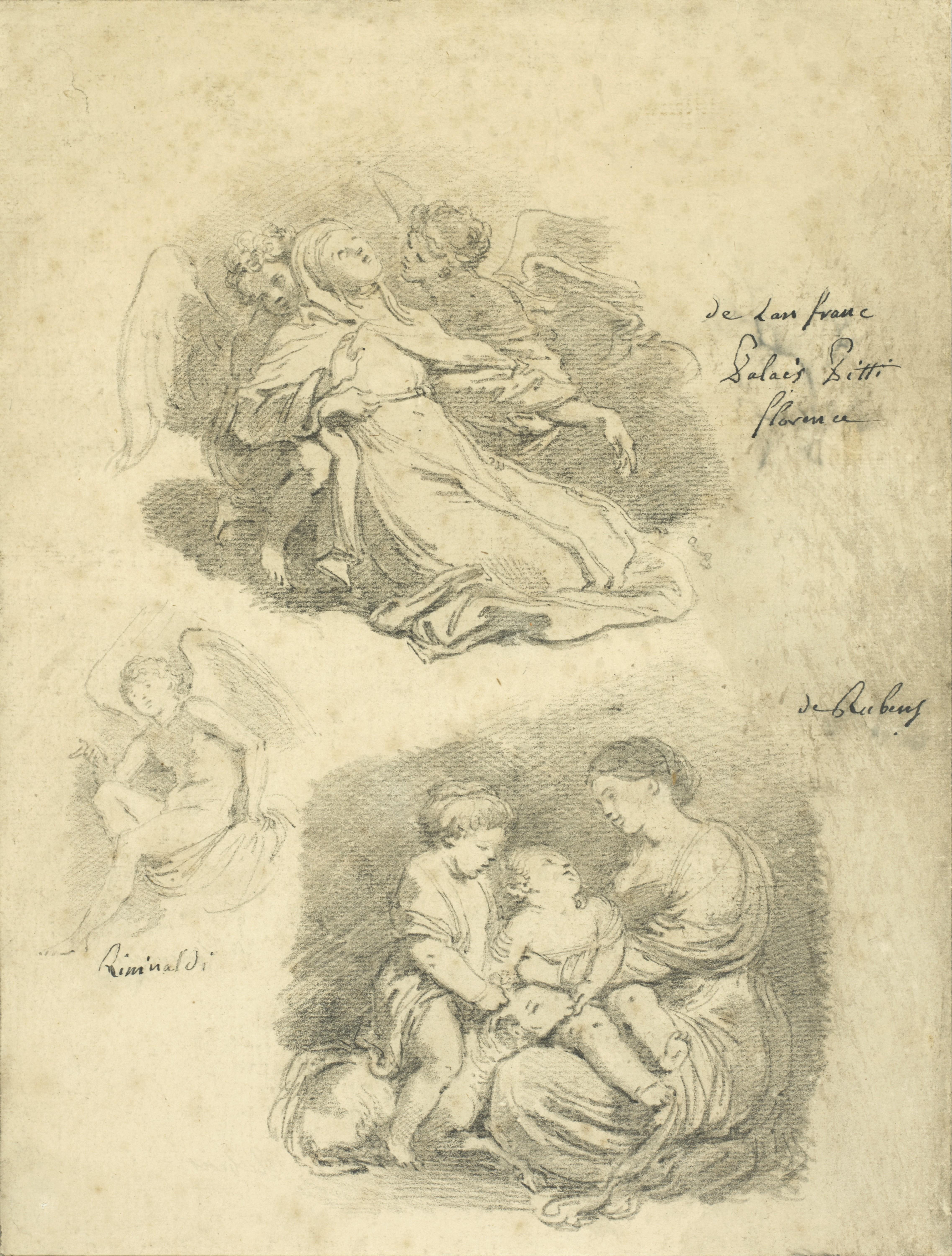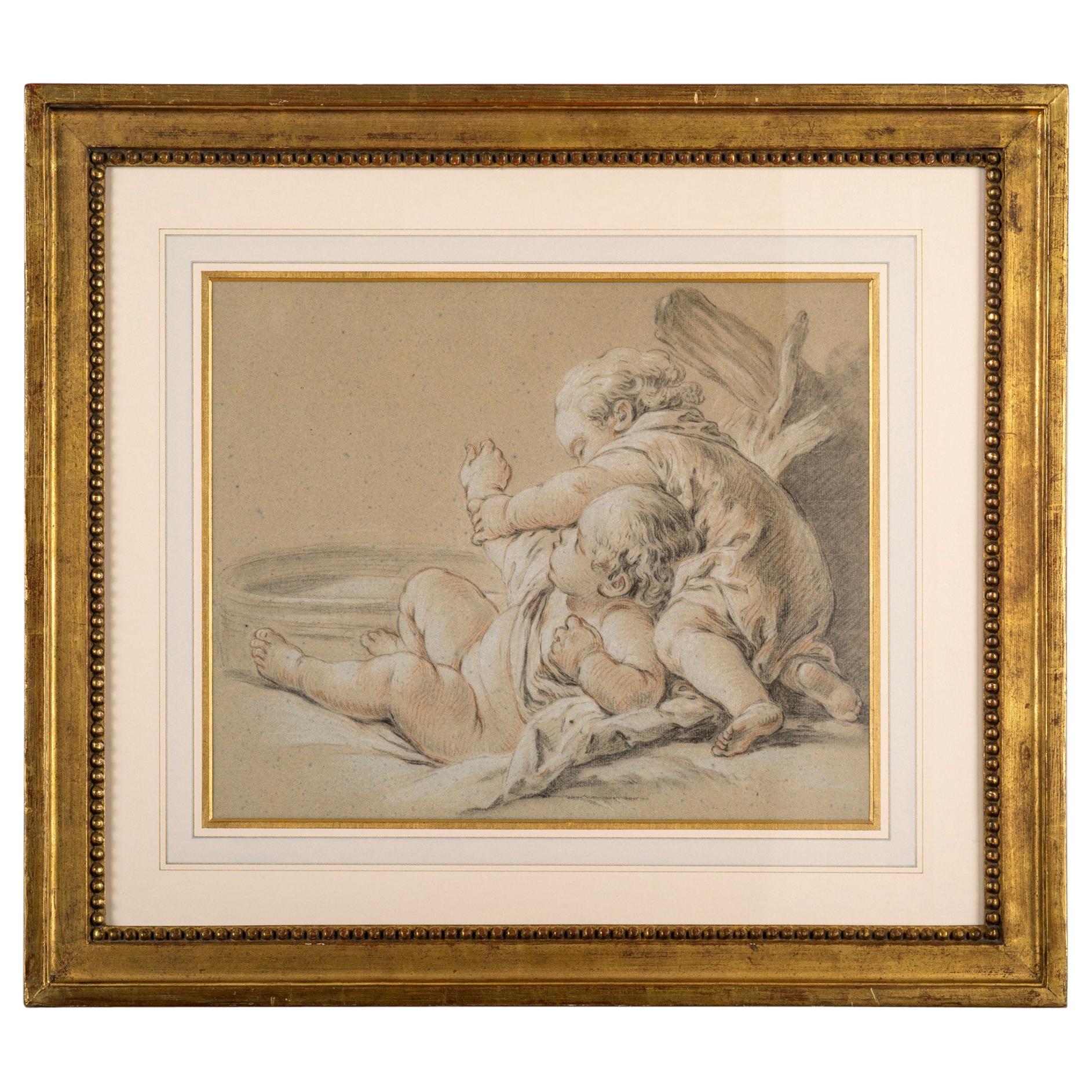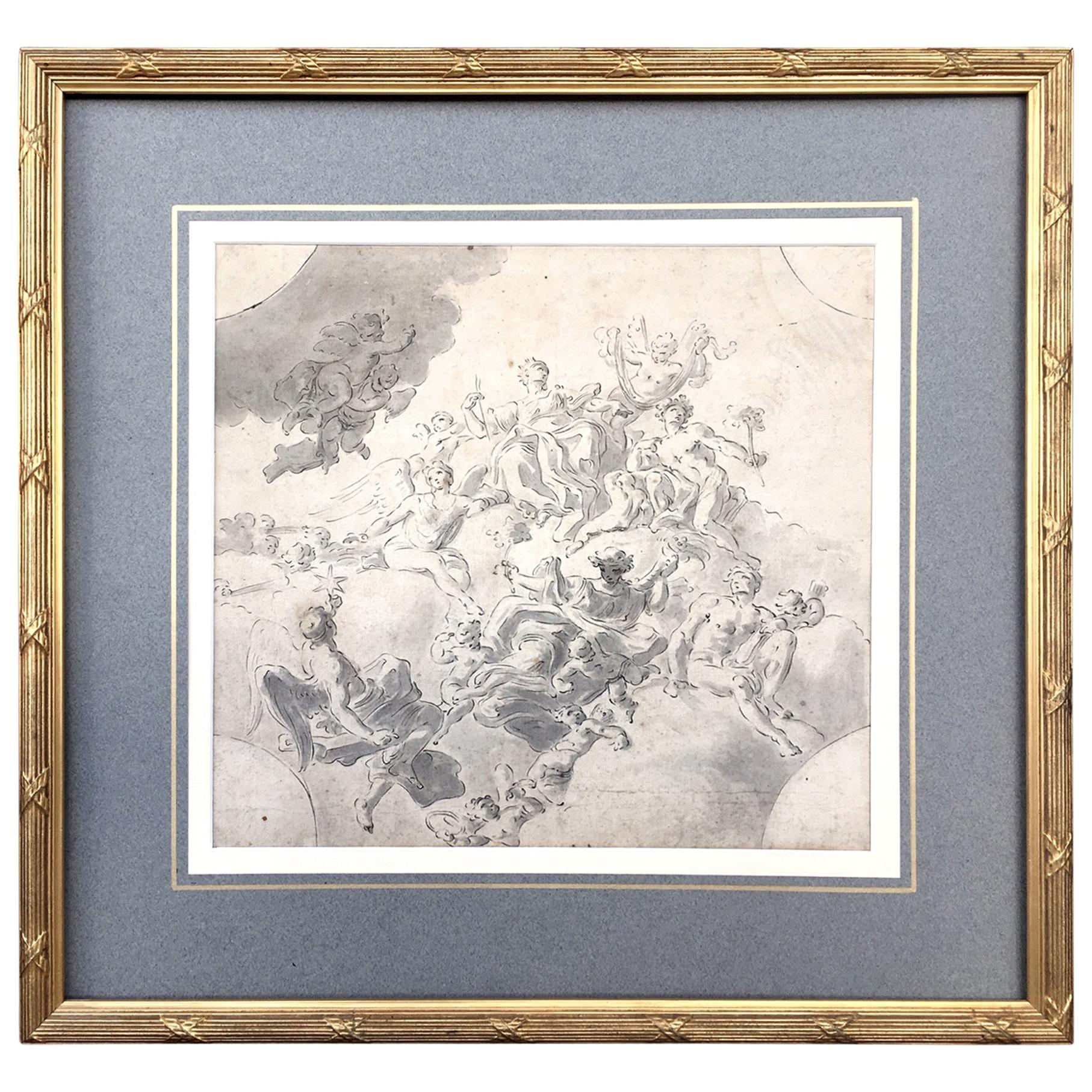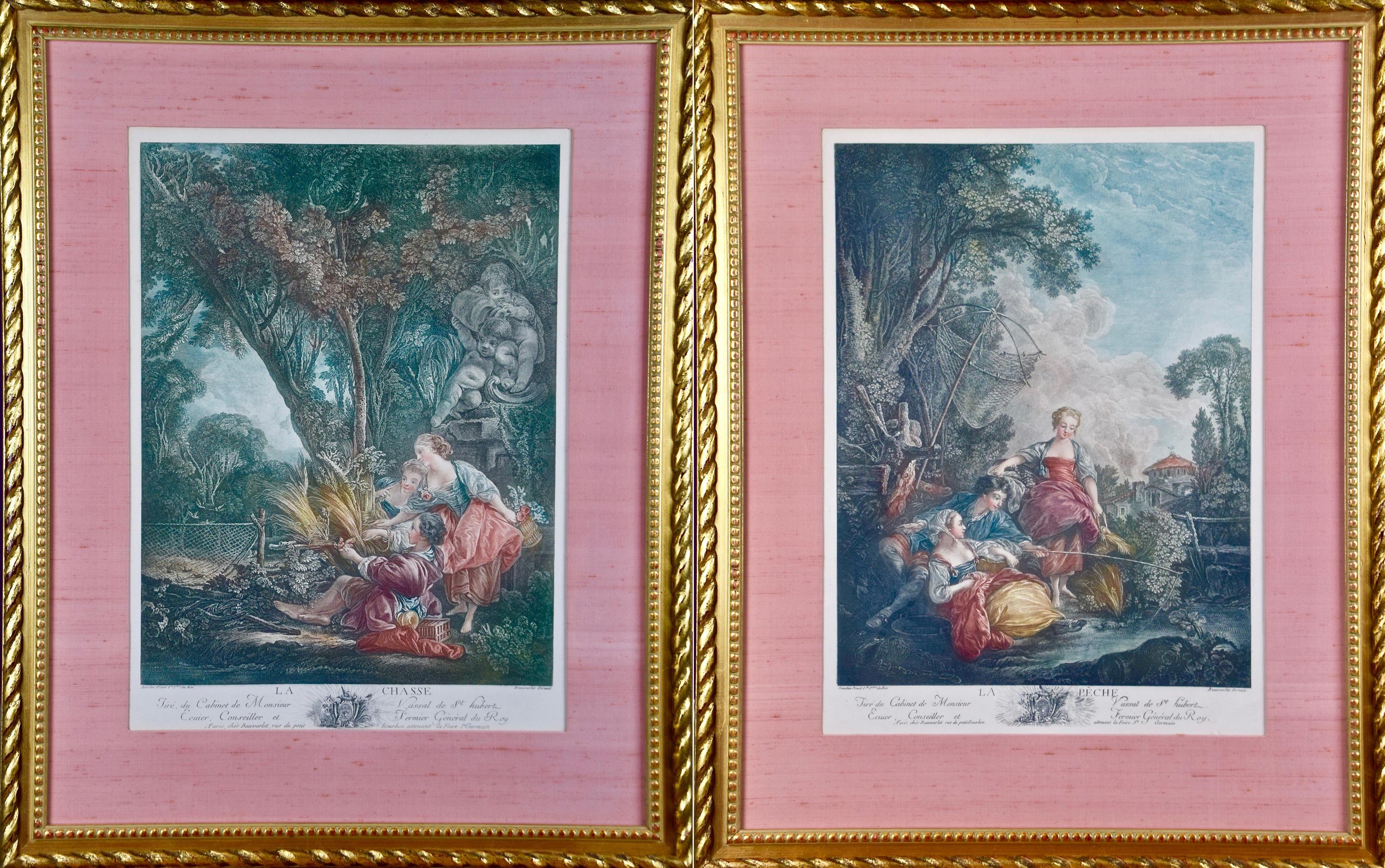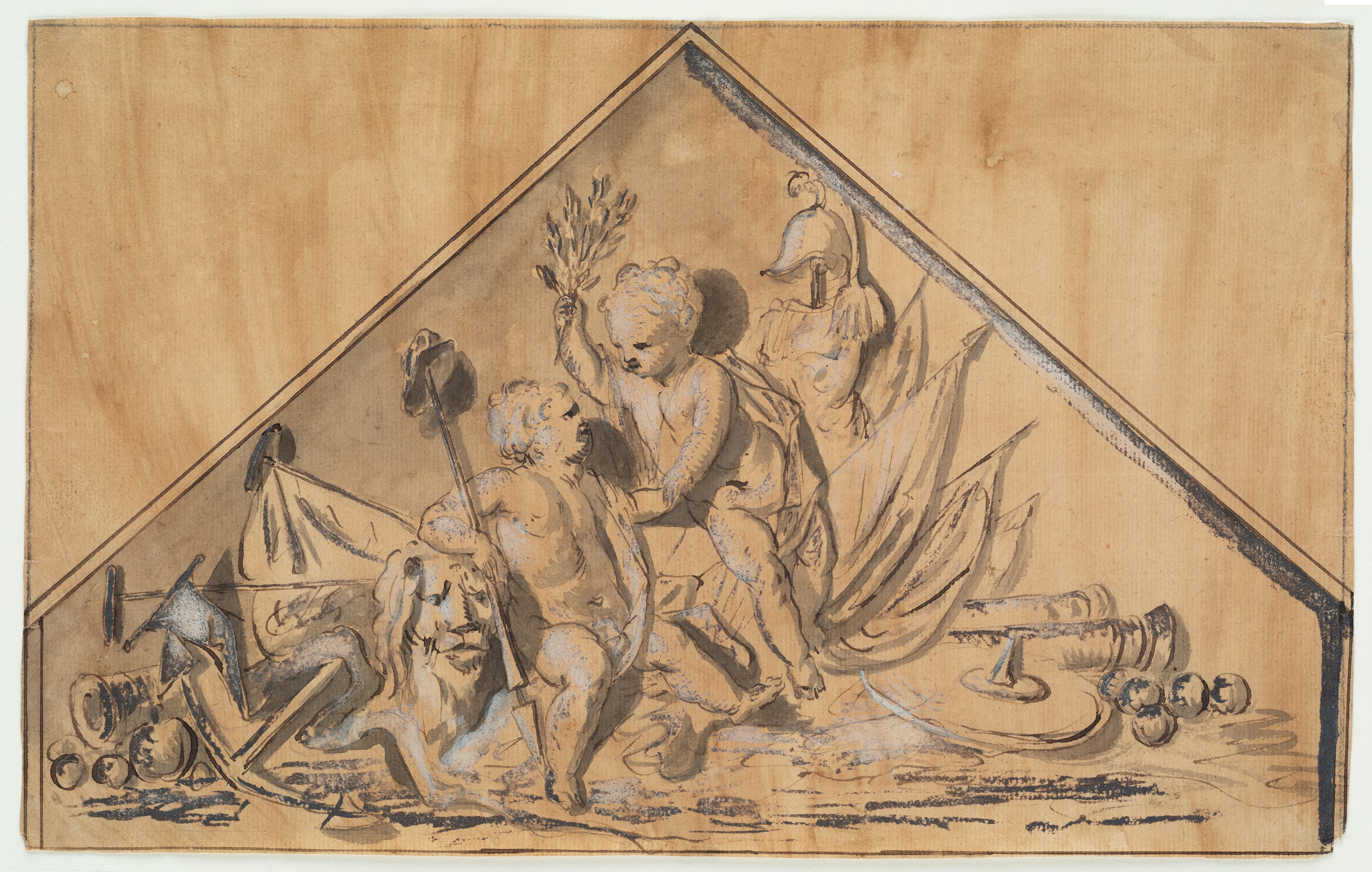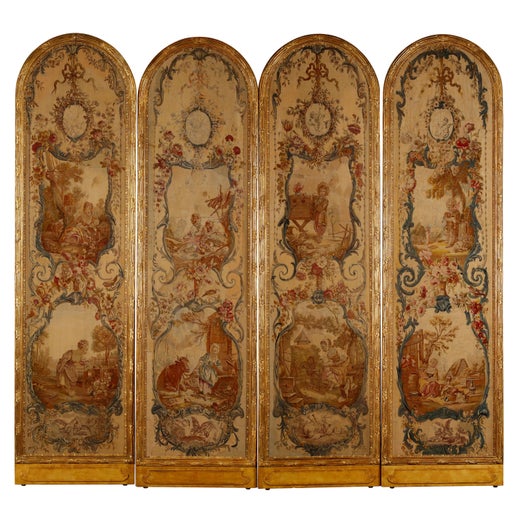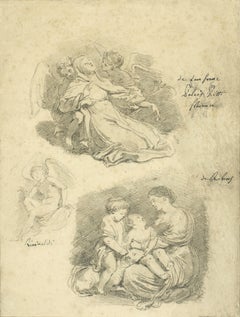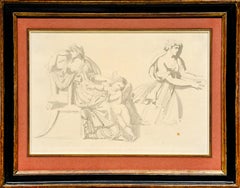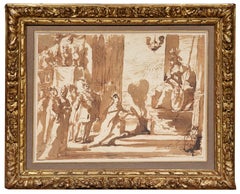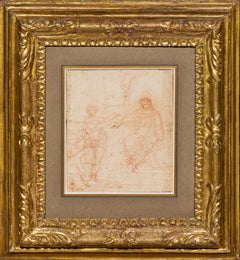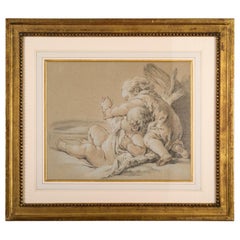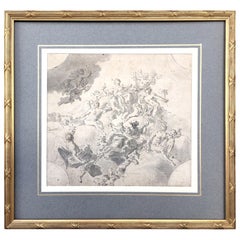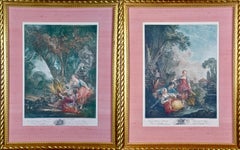Items Similar to Three drawings by François Boucher in a mounting by Jean-Baptiste Glomy
Want more images or videos?
Request additional images or videos from the seller
1 of 11
François BoucherThree drawings by François Boucher in a mounting by Jean-Baptiste GlomyCirca 1756
Circa 1756
$37,913.11
£28,715.96
€32,000
CA$52,850.07
A$57,524.95
CHF 30,301.33
MX$700,226.53
NOK 379,443.36
SEK 356,228.93
DKK 243,757.05
About the Item
We would like to thank Juliette Parmentier-Courreau of the Custodia Foundation for her welcome and support during the consultation of Glomy’s Journal des Ouvrages.
This spectacularly large "feuille de desseins ajustés" commissioned by François Boucher from Jean-Baptiste Glomy is emblematic of the painter's art and mastery of rocaille. It is also fully representative of the taste of this period in the field of decorative arts. The largest of these three drawings, placed at the bottom of the composition, is particularly interesting: dating from around 1756, it constitutes a modello (apparently unpublished) for the frontispiece of the "Catalogue des tableaux de Monsieur de Julienne"), preserved in the Morgan Library in New York.
1. François Boucher, the master of French rocaille
The extraordinary career of Francois Boucher was unmatched by his contemporaries in versatility, consistency and output. For many, particularly the writers and collectors who led the revival of interest in the French rococo during the last century, his sensuous beauties and plump cupids represent the French eighteenth century at its most typical. His facility with the brush, even when betraying the occasional superficiality of his art, enabled him to master every aspect of painting – history and mythology, portraiture, landscape, ordinary life and, as part of larger compositions, even still life. He had been trained as an engraver, and the skills of a draftsman, which he imbued in the studio of Jean-Francois Cars (1661 – 1738), stood him in good stead throughout his career; his delightful drawings are one of the most sought-after aspects of his oeuvre.
As a student of Francois Lemoyne (1688 - 1737), he mastered the art of composition. The four years he spent in Italy, from 1727-1731, educated him in the works of the masters, classics and history, that his modest upbringing had denied him.
On his return to Paris in 1734, he gained full membership of the Royal Academy of Painting and Sculpture with his splendid Rinaldo and Armida (Paris, Musée du Louvre). Although, throughout his career, he occasionally painted subjects taken from the Bible, and would always have considered himself first as a history painter, his own repertoire of heroines, seductresses, flirtatious peasant girls and erotic beauties was better suited to a lighter, more decorative subject matter. His mastery of technique and composition enabled him to move from large scale tapestry cartoons (he worked throughout his career for both the Beauvais and Gobelins tapestry factories, becoming director of the latter in 1755), to intimate masterpieces such as Diana Resting (Paris, Louvre) or Leda and the Swan and the occasional scene from everyday life such as The Luncheon (Paris, Louvre), with its elegantly dressed figures grouped around a well-laid table.
Enormously successful and widely bought, Boucher’s output was prodigious. First patronized by the Crown in the 1730s, and appointed Premier Peintre du Roi in 1765, he executed numerous royal and princely commissions until his death in 1770, working particularly for Louis XV’s mistress, the Marquise de Pompadour in each of her several palaces. Always ready to utilize his talents in other fields, he designed stage sets for theatre and opera and supplied drawings to be used as designs for figures at the Vincennes (later Sèvres) porcelain factory. As a teacher, he was much loved by his many students, who included Fragonard, Le Prince, Deshays, Brenet, Baudouin, Lagrenee, and Madame de Pompadour herself.
In his earliest surviving works with their colourful rococo palette, even David, a distant cousin, was clearly influenced by Boucher. Not since Le Brun had a single French artist held such a monopoly on the imagery of a particular society or left such a mark on the art of his time.
2. Description of the drawings
Although very different, these three drawings are all driven by the same creative spirit and are therefore perfectly representative of Boucher's taste for symbolic or mythological compositions, executed in a style that is both lively and vigorous.
The drawing at the top of the composition (reproduced above) represents a Study of Nymphs: three young women are lying in a charming disorder, while a fourth seems to be floating at the back. Although it is difficult to link this drawing directly to one of Boucher's compositions, the nymph in the middle, with her left leg stretched forward and her arms spread, recalls one of the characters in one of Boucher's last compositions, Mercury Entrusting Bacchus as a Child to the Nymphs of Nysa, painted in 1769.
Typical of the erotic-mythological taste, the drawing in the middle (reproduced below) represents Mars and Venus: Mars, probably guided by Cupid, pulls aside a curtain, and discovers Venus asleep. The subject, taken from Ovid's Metamorphoses (IV, 167-189), has been a classic one since the Renaissance and allows Boucher to depict the naked body of a sleeping beauty with great voluptuousness. We have not found any painting by Boucher related to this sketch.
The third drawing (reproduced below), the largest in the composition, is much better documented. It depicts an allegory of the arts, symbolised by putti practising the arts (sculpture and drawing) in the atmosphere of an amateur's cabinet, cluttered with trinkets and drawing portfolios.
This drawing is undoubtedly the inspiration for the frontispiece of the "Catalogue des tableaux de Monsieur de Julienne" (last photo in the Gallery), a manuscript presenting the painting collection assembled by the art lover Jean de Julienne (1686 - 1766). This catalogue, probably executed around 1756, is now kept in the Morgan Library in New York. Our drawing allows us to confirm that the frontispiece (reproduced below), considered to be by the hand of another artist, is inspired by a preliminary drawing by Boucher. This unknown artist introduced several changes to Boucher’s lively sketch: the putto seated in the middle of the composition (which points to the monogram) was leafing through a drawing portfolio in the sketch, while the two putti on the left have been added, taking up the theme of the drawing portfolio browsing.
3. The talented Mr. Glomy
Son of a mason from Auxerre, Jean-Baptiste Glomy began his apprenticeship in 1729 at the age of eighteen with the merchant Pierre Henry Taumiet. First associated with Helle, a print and drawing dealer, geographer, and adviser to several famous amateurs, Glomy published with him in 1751 the first catalogue of Rembrandt's etchings, based on the manuscript left by Gersaint. Glomy then began to work on his own account from June 1st, 1753 onwards.
Glomy's speciality was the framing and mounting of drawings and prints. Glomy made "desseins ajustés" fashionable, i.e. drawings mounted with a wash or gold fillet. The greatest amateurs and painters of his time (such as the painter François Boucher, who was one of his main clients) entrusted him with their drawings. On the mounts he made, Glomy affixed a dry seal with his name in full or a seal with his initial G (L.1119), as on the mount we are presenting.
He had also invented a new artistic arrangement, which consisted in tracing painted and gilded lines on the reverse side of the glass. This technique was so successful that it was named after its inventor; a drawing or print was said to be glomisé or églomisé, i.e. framed under glass in the manner of Glomy.
In parallel to his mounting activity, Glomy directed art sales, enriching the catalogues with his own reflections to make them less austere (such as that of the Conti sale in 1777).
4. The Journal des Ouvrages
This precious manuscript kept in Paris at the Custodia Foundation (Collection Frits Lugt, inv. 9578) gives us full the details of the orders received by Glomy from 1753 to 1761. Boucher became Glomy’s client as early as July 1754, and the Journal reveals the importance of the orders he placed: 90 "desseins ajustés" and 33 " feuilles de desseins ajustés " in 1754, 33 " desseins ajustés " and 89 " feuilles de desseins ajustés " in 1755, 43 " desseins ajustés" and 60 "feuilles de desseins ajustés " in 1756, etc. The price was 30 sols per mounting with gold, and in 1757 this price was decreased to 20 sols. The same price did apply to “desseins ajustés” and to “feuille de desseins ajustés” (like ours).
The sheet we are presenting is a fascinating example of Boucher's commissions from Glomy and testifies to the taste of an era for "desseins ajustés": once completed, Boucher sold them to amateurs who used them to decorate their homes.
5. Framing
We have chosen to frame this beautiful mounting with a gilded wooden frame carved with pearls and rais-de-cœur from the Louis XVI period.
Main bibliographical references :
Boucher - Catalogue of the Grand Palais exhibition (September 18 1986 - January 5 1987) - RMN 1986
F. Marandet, 'Pierre Remy (1715-97): The Parisian art market in the mid-eighteenth century', Apollo, August 2003
P. Michel, Le Commerce du tableau à Paris dans la seconde moitié du XVIIIe siècle, Villeneuve d'Ascq 2007
- Creator:François Boucher (1703 - 1770, French)
- Creation Year:Circa 1756
- Dimensions:Height: 20.5 in (52.07 cm)Width: 11.63 in (29.55 cm)
- Medium:
- Movement & Style:
- Period:1750-1759
- Condition:Dimensions for the drawings, from top to bottom: 5 ½’’ x 7 7/8’’ (14 x 20 cm); 4 15/16’’x 9 ¾” (12.5 x 24.8 cm) and 7 ½” x 12 13/16” (19 x 32.5 cm) For the mounting: 20 ½” x 11 5/8” - (52 x 29.5 cm) Signed 'F. Boucher' lower right, just below Glomy’s.
- Gallery Location:PARIS, FR
- Reference Number:1stDibs: LU1568211933002
François Boucher
The extraordinary career of Francois Boucher was unmatched by his contemporaries in versatility, consistency and output. For many, particularly the writers and collectors who led the revival of interest in the French rococo during the last century, his sensuous beauties and plump cupids represent the French eighteenth century at its most typical. His facility with the brush, even when betraying the occasional superficiality of his art, enabled him to master every aspect of painting – history and mythology, portraiture, landscape, ordinary life and, as part of larger compositions, even still life. He had been trained as an engraver, and the skills of a draftsman, which he imbued in the studio of Jean-Francois Cars (1661 – 1738), stood him in good stead throughout his career; his delightful drawings are one of the most sought-after aspects of his oeuvre. As a student of Francois Lemoyne (1688 - 1737), he mastered the art of composition. The four years he spent in Italy, from 1727-1731, educated him in the works of the masters, classics and history, that his modest upbringing had denied him. On his return to Paris in 1734, he gained full membership of the Royal Academy of Painting and Sculpture with his splendid Rinaldo and Armida (Paris, Musée du Louvre). Although, throughout his career, he occasionally painted subjects taken from the Bible, and would always have considered himself first as a history painter, his own repertoire of heroines, seductresses, flirtatious peasant girls and erotic beauties was better suited to a lighter, more decorative subject matter. His mastery of technique and composition enabled him to move from large scale tapestry cartoons (he worked throughout his career for both the Beauvais and Gobelins tapestry factories, becoming director of the latter in 1755), to intimate masterpieces such as Diana Resting (Paris, Louvre) or Leda and the Swan and the occasional scene from everyday life such as The Luncheon (Paris, Louvre), with its elegantly dressed figures grouped around a well-laid table. Enormously successful and widely bought, Boucher’s output was prodigious. First patronized by the Crown in the 1730s, and appointed Premier Peintre du Roi in 1765, he executed numerous royal and princely commissions until his death in 1770, working particularly for Louis XV’s mistress, the Marquise de Pompadour in each of her several palaces. Always ready to utilize his talents in other fields, he designed stage sets for theatre and opera and supplied drawings to be used as designs for figures at the Vincennes (later Sèvres) porcelain factory. As a teacher, he was much loved by his many students, who included Fragonard, Le Prince, Deshays, Brenet, Baudouin, Lagrenee, and Madame de Pompadour herself. In his earliest surviving works with their colourful rococo palette, even David, a distant cousin, was clearly influenced by Boucher. Not since Le Brun had a single French artist held such a monopoly on the imagery of a particular society or left such a mark on the art of his time.
About the Seller
5.0
Vetted Professional Seller
Every seller passes strict standards for authenticity and reliability
Established in 2020
1stDibs seller since 2021
10 sales on 1stDibs
- ShippingRetrieving quote...Shipping from: PARIS, France
- Return Policy
Authenticity Guarantee
In the unlikely event there’s an issue with an item’s authenticity, contact us within 1 year for a full refund. DetailsMoney-Back Guarantee
If your item is not as described, is damaged in transit, or does not arrive, contact us within 7 days for a full refund. Details24-Hour Cancellation
You have a 24-hour grace period in which to reconsider your purchase, with no questions asked.Vetted Professional Sellers
Our world-class sellers must adhere to strict standards for service and quality, maintaining the integrity of our listings.Price-Match Guarantee
If you find that a seller listed the same item for a lower price elsewhere, we’ll match it.Trusted Global Delivery
Our best-in-class carrier network provides specialized shipping options worldwide, including custom delivery.More From This Seller
View AllThree studies executed in the Pitti Palace in 1761 by Jean-Honoré Fragonard
By Jean-Honoré Fragonard
Located in PARIS, FR
This brilliant study sheet, of which we present here a counterproof, is a souvenir of Fragonard's return journey from Italy. Between April and September 1761, he accompanied the abbot of Saint-Non on his way back to France. Three studies after the masters taken from the Pitti Palace’s gallery in Florence are gathered on this sheet. Although The Ecstasy of Saint Margaret...
Category
1760s Old Masters Figurative Drawings and Watercolors
Materials
Carbon Pencil
Frieze of antique figures, a drawing by the sculptor Antoine-Denis Chaudet
Located in PARIS, FR
Faithful to the neo-classical taste, sculptor Antoine-Denis Chaudet presents us with a frieze of antique figures executed in gray wash over pencil strokes, which is likely inspired b...
Category
Early 1800s Old Masters Figurative Drawings and Watercolors
Materials
Paper, Pencil, Ink
Allegory of the Treaty of Angoulême, a drawing attributed to Donato Mascagni
Located in PARIS, FR
We would like to thank Mrs. Ursula Verena Fischer Pace for suggesting the attribution to Donato Arsenio Mascagni.
We were immediately seduced by the rich tonalities of this allegory...
Category
1620s Old Masters Figurative Drawings and Watercolors
Materials
Ink
Studies for the Judgment of Solomon, a double-sided drawing by Simone Cantarini
Located in PARIS, FR
In this double-sided red chalk study, Simone Cantarini offers us a double reflection on the theme of the Judgment of Solomon. This sheet reveals his precise style and his sense of de...
Category
1640s Old Masters Figurative Drawings and Watercolors
Materials
Chalk, Laid Paper
From Renaissance Venice to Barocco Naples, a drawing by Francesco La Marra
Located in PARIS, FR
This vigorous drawing presents a brilliant synthesis between the Venetian tradition of Titian, of which it is a distant echo, and the Neapolitan Baroque of Solimena, which strongly i...
Category
Mid-18th Century Old Masters Figurative Drawings and Watercolors
Materials
Paper, Ink, Felt Pen
Study for a Hunting Scene, a red chalk sketch attributed to Karel du Jardin
Located in PARIS, FR
We would like to thank Carolina Trupiano Kowalczyk for suggesting this attribution to Karel du Jardin after direct examination of the artwork. Her study of the drawing (in Italian), ...
Category
1650s Old Masters Figurative Drawings and Watercolors
Materials
Chalk, Ink, Laid Paper
You May Also Like
Mannerist : Lying Nude - Etching
By François Boucher
Located in Paris, IDF
Francois BOUCHER
Mannerist : Lying Nude
Etching
Unsigned
On Vellum 38 x 50 cm (c. 15 x 20 in)
Probably edited c. 1950
Excellent condition
Category
20th Century Mannerist Figurative Prints
Materials
Etching
Drawing of Children Playing, Circle of Francois Boucher
By François Boucher
Located in Kittery Point, ME
Drawing of children playing besides a basin of water. Framed in a Louis XVI giltwood frame. Typical of the style and subjects of Francois Boucher.
Chalk and pencil on paper.
Category
Antique Late 18th Century French Rococo Drawings
Materials
Paper
Original Drawing, Circle of Giovanni Battista Tiepolo 1696-1770 Venice, Italy
By Giovanni Battista Tiepolo
Located in Vero Beach, FL
Original Drawing, Circle of Giovanni Battista Tiepolo 1696-1770 Venice, Italy
Although we offer this old master drawing as circle of Tiepolo, we are convinced, based on the composi...
Category
Antique 18th Century Italian Rococo Drawings
Materials
Paper
Pair of Hand-colored Romantic French Engravings after Francois Boucher
By (After) Francois Boucher
Located in Alamo, CA
A pair of French classical romantic prints original created in the 18th century by Jacques-Firmin Beauvarlet (1731-1797) after paintings by Francois Boucher (1703-1770), utilizing ...
Category
18th Century Romantic Figurative Prints
Materials
Engraving, Etching
Old Master Drawing, Baroque, Jacob de Wit, Allegory of Victory, Putti, Ships
By Jacob De Wit
Located in Greven, DE
Two putti with symbols of war and victory (cannons, cannonballs, armour, anchor, lion's head, laurel branch/ olive branch, flag, staff with helmet) in pediment triangle.
Probably a design for a painting or architecture
Pen-and-ink drawing in black on brownish paper, black wash
Plain gold moulding with UV glass
Allegory of Victory, 18th Century, Old Master Drawing, By De Wit, Figurative
Jacob de Wit...
Category
Late 17th Century Baroque Figurative Drawings and Watercolors
Materials
Paper, Crayon
$2,160 Sale Price
35% Off
François Boitard (1670-1715) Abraham and the Three Angels, original drawing
Located in Paris, FR
François Boitard (1670-1715)
Abraham and the Three Angels,
Signed lower left "F Boitard (...) fecit (...)"
28 x 44 cm
Pen and ink on yellow prepared paper...
Category
Early 1700s Old Masters Figurative Drawings and Watercolors
Materials
Ink
More Ways To Browse
Erotic Drawings
Stage Set Design
Le Brun
Gobelin Tapestry
Gobelins Tapestries
Madame De Pompadour
French Louis Gold Glass Cabinet
Leda And Swan
Preliminary Drawings
Boucher Painting
Beauvais Tapestry
Mars Venus
Peasant Girl
Antique Erotic Drawings
Leda And The Swan Painting
De Morgan
Painting Of Mars And Venus
Trinket Cabinet
